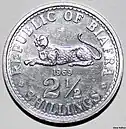Biafran pound
The pound (symbol £) was the currency of the breakaway Republic of Biafra between 1968 and 1970.
| |||||
| Unit | |||||
|---|---|---|---|---|---|
| Symbol | £ | ||||
| Denominations | |||||
| Subunit | |||||
| 1⁄20 | shilling | ||||
| 1⁄240 | penny | ||||
| Plural | |||||
| penny | pence | ||||
| Symbol | |||||
| shilling | s or /– | ||||
| penny | d | ||||
| Banknotes | 5/–, 10/–, £1, £5, £10 | ||||
| Coins | 3d, 6d, 1/–, 2/6 | ||||
| Demographics | |||||
| User(s) | Biafra | ||||
| Issuance | |||||
| Central bank | Bank of Biafra | ||||
| This infobox shows the latest status before this currency was rendered obsolete. | |||||
Context
The Republic of Biafra existed from 1967 to 1970 as an independent state between Nigeria and Cameroon. The central bank of Biafra was one of the first institutions created. It was then decided to maintain the Nigerian pound. The young Republic relied heavily on foreign exchange for cash, which turned into a risky venture.[1]
On 27 January 1968, Biafran President C. Odumegwu Ojukwu declared:[1]
"Fellow countrymen, I am happy to announce to you that I have today signed a decree introducing Biafran currency notes which will be the legal tender throughout the Republic of Biafra. By that same decree, Nigeria currency notes will cease to be legal tender in Biafra. Our new currency notes, along with our new postage stamps, will be issued to the public on January 29, 1968."
The first notes, in denominations of 5/– and £1, were introduced on January 29, 1968.[2] A series of coins was issued in 1969; 3d, 6d, 1/–, and 2s 6d coins were minted, all struck in aluminium. In February 1969, a second family of notes was issued in denominations of 5/– and 10/–, £1, £5 and £10. Despite not being recognised currency by the rest of the world when issued, the banknotes were afterwards sold as curios (typically at an eighth of their face value, or 2/6 sterling for Biafran £1) in British notaphily shops. The notes are now traded among banknote collectors at well above their original nominal value.
The most commonly found notes are the 1968 and 1969 £1 notes, with the £10 note and all coins being rare.
| Banknotes of the Biafran pound (1968 "First" issue) | ||
|---|---|---|
| Value | Obverse | Reverse |
| 5/– | Palm tree over a rising sun | Four Biafran girls |
| £1 | Palm tree over a rising sun | Coat of arms of Biafra |
| Banknotes of the Biafran pound (1969 "Second" issue) | ||
|---|---|---|
| Value | Obverse | Reverse |
| 5/– | Palm tree over a rising sun | Four Biafran girls |
| 10/– | Palm tree over a rising sun | Oil refinery |
| £1 | Palm tree over a rising sun | Coat of arms of Biafra |
| £5 | Palm tree over a rising sun | A female weaver |
| £10 | Palm tree over a rising sun | A male carver |
References
- "Biafra Currency". www.biafraland.com. Retrieved 2023-06-09.
- Linzmayer, Owen (2011). "Biafra". The Banknote Book. San Francisco, CA: www.BanknoteNews.com. Retrieved 2011-08-21.
External links
- Banknotes of Biafra."Archived copy". Archived from the original on 2011-06-29. Retrieved 2006-01-13.
{{cite web}}: CS1 maint: archived copy as title (link) CS1 maint: bot: original URL status unknown (link) - Coins with Nigerian naira
- A detailed article on the banknotes of the Biafran pound pjsymes.com.au
- Biafra: Coins Issued and Used Online Coin Club


.svg.png.webp)